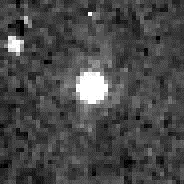(145452) 2005 RN43
 Hubble Space Telescope image of 2005 RN43, taken on April 2010 | |
| Discovery[1] | |
|---|---|
| Discovered by | A. C. Becker A. W. Puckett J. M. Kubica |
| Discovery site | APO |
| Discovery date | 10 September 2005 |
| Designations | |
| (145452) 2005 RN43 | |
| TNO Cubewano[2][3] Extended (DES)[4] | |
| Orbital characteristics[2] | |
| Epoch 13 January 2016 (JD 2457400.5) | |
| Uncertainty parameter 3 | |
| Observation arc | 22376 days (61.26 yr) |
| Earliest precovery date | 2 June 1954 |
| Aphelion | 42.146 AU (6.3050 Tm) |
| Perihelion | 40.571 AU (6.0693 Tm) |
| 41.359 AU (6.1872 Tm) | |
| Eccentricity | 0.019047 |
| 265.99 yr (97151.5 d) | |
Average orbital speed | 0.0037°/d |
| 338.28° | |
| 0° 0m 13.34s / day | |
| Inclination | 19.313° |
| 186.93° | |
| ≈ 15 June 2029[5] ±9 days | |
| 174.88° | |
| Earth MOID | 39.5672 AU (5.91917 Tm) |
| Jupiter MOID | 35.6155 AU (5.32800 Tm) |
| TJupiter | 5.446 |
| Physical characteristics | |
| Dimensions | 679+55 −73 km[6] |
| 6.95 h (0.290 d) | |
| 5.62 h[2] | |
| 0.107+0.029 −0.018[6] | |
| IR–RR (red)[6] B–V=0.95±0.02[7] V–R=0.59±0.01[7] V–I=1.08±0.02[7] | |
| 20.1[8] | |
| 3.89±0.05[6] 3.9[2] | |
(145452) 2005 RN43 (provisional designation 2005 RN43) is a classical Kuiper belt object. It has an estimated diameter of 679+55
−73 km.[6] It was discovered by Andrew Becker, Andrew Puckett and Jeremy Kubica on 10 September 2005 at Apache Point Observatory in Sunspot, New Mexico. Brown estimates that it is possibly a dwarf planet.[9][10]
Classification[edit]
The Minor Planet Center (MPC) classifies it as a cubewano.[3] But since this object has an inclination of 19.3°, the Deep Ecliptic Survey (DES) classifies it as scattered-extended.[4]
It has been observed 119 times over thirteen oppositions, with precovery images back to 1954.[2]
See also[edit]
References[edit]
- ^ "List Of Transneptunian Objects". Minor Planet Center. Retrieved 22 August 2016.
- ^ a b c d e "JPL Small-Body Database Browser: 145452 (2005 RN43)" (2015-08-13 last obs). Retrieved 11 April 2016.
- ^ a b "MPEC 2009-R09 :Distant Minor Planets (2009 September 16.0 TT)". IAU Minor Planet Center. 2009-09-04. Retrieved 2010-01-08.
- ^ a b Marc W. Buie. "Orbit Fit and Astrometric record for 145452" (2008-08-09 using 220 of 221 observations). SwRI (Space Science Department). Retrieved 2009-10-04.
- ^ JPL Horizons Observer Location: @sun (Perihelion occurs when deldot changes from negative to positive. Uncertainty in time of perihelion is 3-sigma.)
- ^ a b c d e Vilenius, E.; Kiss, C.; Mommert, M.; et al. (2012). ""TNOs are Cool": A survey of the trans-Neptunian region VI. Herschel/PACS observations and thermal modeling of 19 classical Kuiper belt objects". Astronomy & Astrophysics. 541: A94. arXiv:1204.0697. Bibcode:2012A&A...541A..94V. doi:10.1051/0004-6361/201118743. S2CID 54222700.
- ^ a b c Belskaya, Irina N.; Barucci, Maria A.; Fulchignoni, Marcello; Lazzarin, M. (April 2015). "Updated taxonomy of trans-neptunian objects and centaurs: Influence of albedo". Icarus. 250: 482–491. Bibcode:2015Icar..250..482B. doi:10.1016/j.icarus.2014.12.004.
- ^ "AstDys (145452) 2005RN43 Ephemerides". Department of Mathematics, University of Pisa, Italy. Retrieved 2009-12-07.
- ^ Michael E. Brown. "How many dwarf planets are there in the outer solar system? (updates daily)". California Institute of Technology. Archived from the original on 2011-10-18. Retrieved 2011-08-25.
- ^ Tancredi, Gonzalo (2009), "Physical and dynamical characteristics of icy "dwarf planets" (plutoids)", Proceedings of the International Astronomical Union, 5: 173–185, Bibcode:2010IAUS..263..173T, doi:10.1017/S1743921310001717


